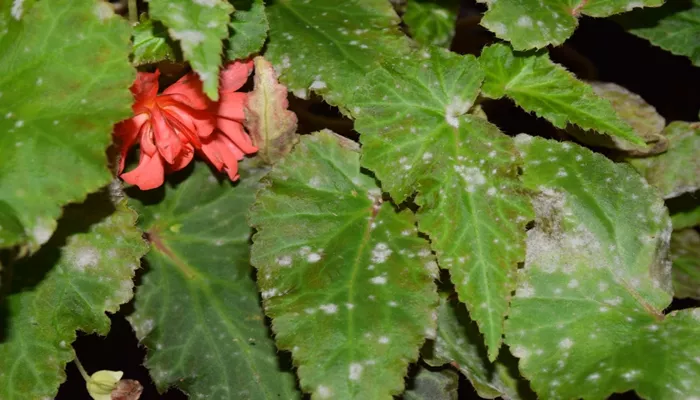Dear Master Gardener: My begonias have white mold on the leaves. They’re in a small, shady courtyard. Can I treat them to remove the mold?
Answer: The white mold you see is likely powdery mildew, a common fungal disease that appears as white to gray powdery patches on leaves, stems, and buds. It often thrives in the humid and rainy conditions we’ve had this summer. Plants in shaded areas with poor air circulation are particularly susceptible. While powdery mildew can make plants look unattractive, it generally doesn’t harm their overall health, so treatment isn’t usually necessary. If the disease is severe, it may stunt growth or reduce flowering, but it’s best to tolerate low levels that don’t significantly impact the plant.
Dear Master Gardener: My cannas have seed pods on the stems. Should I remove them?
Answer: The spiky, green seed pods that form as canna flowers fade don’t have to be removed. However, for a tidier appearance, I recommend trimming off both the spent flowers and seed pods.
Dear Master Gardener: I saw purple loosestrife in a friend’s garden. Isn’t it invasive and illegal? Is yellow loosestrife also invasive?
Answer: Purple loosestrife (Lythrum salicaria), a plant native to Europe, is highly invasive and can take over wetlands, choking out native vegetation. Because of its aggressive nature, it’s illegal to grow purple loosestrife anywhere in Minnesota. This plant was classified as a noxious weed in 1987, and it is illegal to sell or transport it. Landowners are responsible for controlling or destroying noxious weeds to prevent their spread.
Yellow loosestrife (Lysimachia), on the other hand, is not illegal in Minnesota. It’s a hardy perennial with attractive flowers and foliage, but it can spread rapidly, so it’s considered aggressive. If you plant it in your garden, you may want to use a physical barrier to control its spread or be prepared to divide it regularly. Several species and cultivars of yellow loosestrife are available, including fringed loosestrife, which is native to the northeastern U.S. and features small yellow flowers that bloom in mid-summer. Gooseneck loosestrife, another species, produces distinctive arching white flowers but is considered invasive.
Lowland yellow loosestrife (Lysimachia hybrida) is native to Minnesota and often found in wetlands and along riverbanks. It is sometimes mistaken for fringed loosestrife but can be distinguished by its narrower, less hairy leaves and a more open branching pattern. This wildflower blooms in July and August.
Dear Master Gardener: Is now a good time to divide my perennials?
Answer: It depends on the type of perennial. Spring and summer blooming perennials can be divided now, but avoid dividing them while they are in bloom. Ideally, divide perennials on a cloudy day to minimize stress, and it’s best if rain is in the forecast to help them settle in. However, as weather predictions can be unreliable, don’t rely solely on the forecast. Perennials with fleshy roots, like peonies, Oriental poppies, and Siberian irises, are better divided in the fall, about four to six weeks before the ground freezes. Other perennials that can be divided now include Ajuga, Allium, Astilbe, Brunnera, Columbine, Coreopsis, Creeping Phlox, Heuchera, Hosta, Lady’s Mantle, Lilies, Pulmonaria, Salvia (divide when the center dies), Tiarella, and Veronica. Daylilies (Hemerocallis) can be divided after blooming or in spring.
Dear Master Gardener: Some of my tomatoes are rotting at the bottom, turning tan, then black and sunken. Is it safe to eat the tomatoes? Should I pull out the plant?
Answer: The issue you’re describing is Blossom End Rot, a common problem in tomatoes, peppers, and eggplants. Roma tomatoes are especially prone to this disorder, which is caused by a lack of calcium due to inconsistent moisture levels. To prevent it, ensure your plants receive a deep watering of at least one inch per week. Sandy soils may need more frequent watering. The affected tomatoes are still safe to eat; simply cut off the damaged part, and the rest of the tomato is fine. There’s no need to pull out the plant.


